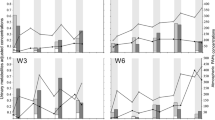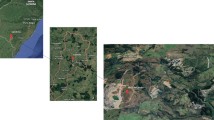Summary
Biological monitoring is an efficient tool in the evaluation of exposure to chemical agents. However, the dose-response of adverse health effects using biological exposure indices and biological limit values are rarely available. This paper presents an estimation of the occupational exposure limit value of 1-hydroxypyrene in urine, a biological exposure indicator of polycyclic aromatic hydrocarbons (PAH). A large-scale study of the exposure of cokeoven workers to PAH, in wich both air sampling (benzene soluble matter and individual PAH including benzo(α)pyrene) and biological monitoring (1-hydroxypyrene in urine) were applied, made it possible to establish an empirical mathematical relationship between the air sampling data and biological monitoring data. It was calculated that cokeoven workers with a urinary concentration of 1-hydroxypyrene of 2.3 μmol/mol creatinine after a 3-day working period equals the airborne threshold limit value (TLV) of coal tar pitch volatiles (CTPV). Epidemiological studies have quantified the relative risk of lung cancer for topside and non-topside cokeoven workers. The published environmental exposure data of topside and non-topside cokeoven workers were used to determine the time-average exposure. The data of 1-hydroxypyrene in the urine of cokeoven workers and data of epidemiological studies from different coke plants were combined according to the concentrations of PAH in the air. Thus, it was possible to establish an indirect relationship between lung cancer mortality risk and the biological exposure indicator for cokeoven workers. Exposure at the level of the suggested tentative biological exposure limit (BEL) of 2.3 μmol/ mol creatinine is estimated to be equal to a relative risk of lung cancer of approximately 1.3.
Similar content being viewed by others
References
Lindstedt G, Sollenberg J (1982) Polycyclic aromatic hydrocarbons in the occupational environment. Scand J Work Environ Health 8:1–19
Lloyd WJ, Ciocco A (1969) Long term mortality study of steelworkers: I. Methodology. J Occup Med 11:299–310
Lloyd WJ (1972) Long-term mortality study of steelworkers: V. Respiratory cancer in coke plant workers. J Occup Med 13:53–68
Doll R, Vessey MP, Beasley RWR, Buckley AR, Fear EC, Fisher REW, Gammon EJ, Gunn W, Hughes GO, Lee K, Norman-Smith G (1972) Mortality of gas workers — final report of a prospective study. Br J Ind Med 29:394–406
Sakabe H, Tsuchiya K, Takekura N, Nomura S, Koshi S, Takemoto K, Matsushita H, Matsuo Y (1975) Lung cancer among cokeoven workers. Ind Health 13:57–68
Redmond CK, Ciocco JW (1972) Long term mortality study of steelworkers: IV. Mortality from malignant neoplasms among cokeoven workers. J Occup Med 14:621–629
Redmond CK, Strobono BR, Cypress RH (1976) Cancer experience among coke by-product workers. Ann NY Acad Sci 271:102–115
Redmond CK, Wieand HS, Rochette HE, Sass R, Wiberg G (1981) Long term mortality experience of steelworkers. DHHS (NIOSH) Publ. No. 81-120, Cincinnati
International Agency for Research on Cancer (1984) IARC monographs on the evaluation of the carcinogenic risk of chemicals to human. Polynuclear aromatic compounds. Part 3: industrial exposures in aluminium production, coal gasification, coke production and iron and steel founding. Volume 34: IARC, Lyon
Bertrand JP, Chan N, Patris A, Mar JM, Pham QT, Moulin JJ, Morviller P, Auburtin G, Figueredo A, Martin J (1987) Mortality due to respiratory cancers in the cokeoven plants of the Lorraine coalmining industry. Br J Ind Med 44:559–565
Swaen GMH (1989) Epidemiological cancer mortality studies in occupational health. PH. D. Thesis, University of Maastricht, The Netherlands
Mazumdar S, Redmond C, Sollecito W, Sussmann N (1975) An epidemiological study of exposure to coal tar pitch volatiles among coke oven workers. J Air Poll Control Assoc 25:382–389
US Environmental Protection Agency (1984) Carcinogen risk assessment of coke oven emissions. Final report no. EPA-600/6-82-003F. EPA, Washington, D.C.
Pott F (1985) Pyrolyse, Abgas, und Lungenkrebsrisiko. Daten und Bewertung. Staub Reinh Luft 45:369–379
World Health Organization (1987) Air quality guidelines for Europe. WHO regional publications European series no. 23. WHO, Kopenhagen, pp 105–107
ACGIH (1986) Documentation of threshold limit values and biological exposure indices. ACGIH, Cincinnati
Jongeneelen FJ, Leeuwen FE v, Oosterink S, et al (1990) Ambient and biological monitoring of cokeoven workers; determinants of internal dose of PAH. Br J Ind Med 47:454–461
Schooten FJ v, Leeuwen FE v, Hillebrand MJX, Rijke M de, Hart AAM, Veen HG v., Oosterink S, Kriek E (1990) Determination of benzo(α)pyrene-diol epoxide-DNA adducts in white blood cell DNA from coke-oven workers: the impact of smoking. JNCI 82:927–933
Jongeneelen FJ, Anzion RBM, Leijdekkers CM, Bos RP, Henderson PT (1985) 1-Hydroxypyrene in human urine after exposure to coal tar and a coal tar derived product. Int Arch Occup Environ Health 57:47–55
Jongeneelen FJ, Bos RP, Anzion RBM, Theuws JLG, Henderson PT (1986) Biological monitoring of polycyclic aromatic hydrocarbons: metabolites in urine. Scand J Work Environ Health 12:137–143
Jongeneelen FJ, Anzion RBM, Scheepers PTJ, et al (1988) 1-Hydroxypyrene in urine as a biological indicator of exposure to polycyclic aromatic hydrocarbons in several work environments. Ann Occup Hyg 32:35–43
Tolos WP, Shaw PB, Lowry LK, Mackenzie BA, Deng JF, Markel HL (1990) 1-Pyrenol: a biomarker for occupational exposure to PAH. Appl Occup Environ Hyg 5:303–309
Clonfero E, Zordan M, Venier P, et al (1989) Biological monitoring of human exposure to coal tar. Urinary excretion of total PAH, 1-hydroxypyrene and mutagens in psoriatic patients. Int Arch Occup Environ Health 61:363–369
Jongeneelen FJ, Akker W v.d., Bos RO, Anzion RBM, Theuws JLG, Roelofs HJM, Henderson Pt (1988) 1-Hydroxypyrene as an indicator of the mutagenicity of coal tar after activation with human liver preparations. Mutat Res 204:195–201
Leung HW, Paustenbach DJ (1988) Application of pharmacokinetics to derive biological exposure indexes from threshold limit values. Am Ind Hyg Assoc 49:445–450
Fanninck N, Gonshor LT, Shockley JR (1972) Exposure to coal pitch volatiles at coke ovens. Am Ind Hyg Assoc J 33:461–468
Lesage J, Perrault G, Durand P (1987) Evaluation of worker exposure to polycyclic aromatic hydrocarbons. Am Ind Hyg Assoc J 48:753–759
Blome H (1981) Messungen polycyclischer aromatischer Kohlenwasserstoffe an Arbeitsplätzen. Beurteilung der Ergebnisse. (Measurements of PAH in the work environment. Interpretation of results.) Staub Reinh Luft 41:225–229
König J, Balfanz E, Bechtloff G (1985) Zusammensetzung von PAH-gemischen an unterschiedlichen Arbeitsplätzen (Composition of PAH-mixtures in several workplaces. (Report Fb 431) Bundesanstalt für Arbeitsschutz, Dortmund
Jongeneelen FJ, Scheepers PTJ, Groenendijk A, et al (1988) Airborne concentrations, skin contamination, and urinary metabolite excretion of polycyclic aromatic hydrocarbons among paving workers exposed to coal tar derived road tars. Am Ind Hyg Assoc J 49:600–607
Wolff MS, Herbert R, Marcus M, Rivera M, Landrigan PJ, Andrews LR (1989) Polycyclic aromatic hydrocarbons residues on skin in relation to air levels among roofers. Arch Environ Health 44:157–163
Vo-dinh T (1987) Evaluation of an improved fiberoptics luminescence skin monitor with background correction. Am Ind Hyg Assoc J 48:594–598
Clonfero E, Jongeneelen FJ, Zordan M, Levis AG (1989) Biological monitoring of human exposure to coal tar. Urinary mutagenicity assays and analytical determination of PAH in urine. In: Proceedings of symposium “Experimental and epidemiological application to risk assessment of complex mixtures”. Espoo, Finland
Zhao Z-H, Quan W-Y, Tian D-H (1990) Urinary 1-hydroxypyrene as an indicator of human exposure to ambient polycyclic aromatic hydrocarbons in a coal burning environment. Sci Total Environ 92:145–154
Sikström E, Levin JO (1989) Urine levels of 1-hydroxypyrene in cokeoven workers (abstract). Am Ind Hyg Conf, St Louis
Author information
Authors and Affiliations
Rights and permissions
About this article
Cite this article
Jongeneelen, F.J. Biological exposure limit for occupational exposure to coal tar pitch volatiles at cokeovens. Int. Arch Occup Environ Heath 63, 511–516 (1992). https://doi.org/10.1007/BF00386338
Received:
Accepted:
Issue Date:
DOI: https://doi.org/10.1007/BF00386338




